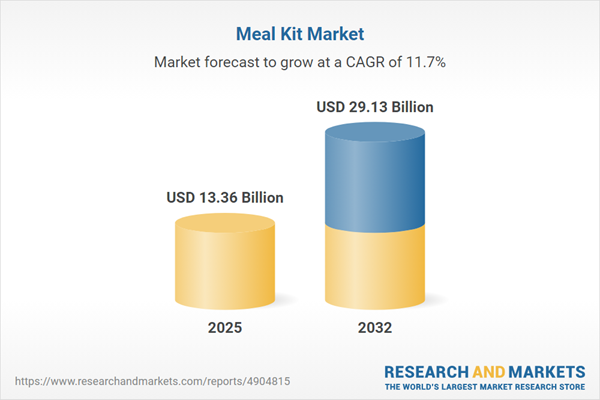Speak directly to the analyst to clarify any post sales queries you may have.
Senior executives in the global meal kit market are challenged by accelerating digitalization, evolving consumer behavior, and demand for convenience-driven solutions. Strategic flexibility and operational resilience are now critical for driving sustained growth as leaders navigate regulatory complexities and shifting preferences.
Market Snapshot: Global Meal Kit Market Dynamics
The global meal kit market is experiencing robust advancement, shaped by changes in consumer meal planning, strong uptake of digital ordering, and preference for personalized dining experiences. Adoption of technology-powered platforms is streamlining service delivery and enabling companies to foster lasting customer connections. Established meal kit providers increasingly leverage integrated technology to target and engage consumers at every key decision stage. The sector’s momentum is further supported by continuous product innovation and rapid adaptation to lifestyle and dietary trends. Strategic agility remains essential for companies seeking to compete as consumer-centric models and competitive pressures accelerate, prompting meal kit brands to evolve service portfolios and enhance responsiveness.
Scope & Segmentation: Global Meal Kit Market
- Service Models: Subscription-based offerings support ongoing customer engagement, while single-purchase kits increase reach to new and infrequent users, bolstering acquisition strategies.
- Meal Types: Non-vegetarian kits (poultry, seafood), vegetarian, and plant-based alternatives enable brands to address varied dietary needs and foster inclusivity within product lines.
- Cuisine Types: Offerings encompass American, Asian, Italian, as well as specialty cuisines including BBQ, Tex-Mex, Chinese, and Japanese, catering to a wide range of global tastes.
- Distribution Channels: Multiple access points such as grocery stores, specialty retailers, brand-owned e-commerce, and third-party platforms improve accessibility and convenience across customer segments.
- End Users: Household consumers, workplace canteens, and educational institutions benefit from tailored meal kit services designed for operational efficiency and situational flexibility.
- Regional Coverage: The market adapts to local consumer preferences, regulations, and sustainability expectations across the Americas, Europe, Middle East and Africa, and Asia-Pacific.
- Leading Companies: Key industry participants—HelloFresh SE, Blue Apron, The Kroger Co., Home Chef, Marley Spoon, Tyson Foods, Cumin Club, CookUnity LLC, Mosaic Foods, Daily Harvest, FlexPro Meals, Freshly Inc., Oisix ra daichi, Tovala, Trifecta Nutrition—shape the competitive landscape through operational innovation and differentiated service models.
Key Takeaways for Senior Decision-Makers
- Utilizing digital and mobile platforms enhances visibility across the value chain, providing actionable insights into consumer behaviors and supporting agile strategy adjustments.
- Strengthening logistics and fulfillment networks ensures reliable, timely delivery and maintains service standards that cultivate customer loyalty and trust.
- Investing in sustainable practices, such as eco-friendly packaging and responsible sourcing, aligns with core procurement values and meets the expectations of environmentally conscious buyers.
- Extending integration between physical and digital retail enhances market penetration, broadens sales opportunities, and diversifies risk exposure.
- Implementing process automation and advancing supply chain transparency fortifies operational stability and protects business margins amid ongoing industry changes.
Tariff Impact in the United States
Changes in U.S. tariff regulations have introduced added complexity for procurement and cost management within the meal kit sector. Executive responses center on strengthening domestic supply relationships and expanding product assortments, which provide greater flexibility in adapting to shifting pricing structures and maintain consistent service quality despite regulatory fluctuations.
Research Methodology & Data Sources
Research for this report draws from detailed interviews with senior market executives, comprehensive industry surveys, and leading data from retail and institutional suppliers. Supplementary benchmarking and regulatory analyses enhance the relevance for strategic planning by senior leadership teams.
Why This Report Matters for Senior Leadership
- Enables strategic adaptation of digital and operational models to emerging industry challenges.
- Supports responsive, data-driven decision-making to address changing regulations and consumer expectations across regions.
- Delivers a framework for aligning resource allocation and long-term planning to maximize competitive position in the global meal kit market.
Conclusion
This report provides actionable guidance for senior leaders seeking to reinforce operational resilience and refine strategic direction in an evolving global meal kit landscape.
Additional Product Information:
- Purchase of this report includes 1 year online access with quarterly updates.
- This report can be updated on request. Please contact our Customer Experience team using the Ask a Question widget on our website.
Table of Contents
3. Executive Summary
4. Market Overview
7. Cumulative Impact of Artificial Intelligence 2025
List of Figures
Companies Mentioned
The companies profiled in this Meal Kit market report include:- Cumin Club
- CookUnity LLC
- Blue Apron, LLC by Wonder Group
- Daily Harvest
- Diet-to-Go
- FlexPro Meals
- Freshly Inc. by Nestlé S.A.
- Gobble Inc.
- Gousto
- HelloFresh SE
- Home Chef
- Marley Spoon by MMM Consumer Brands Inc.
- Meal Kit Supply
- Mosaic Foods, Inc.
- Oisix ra daichi Inc.
- Pepper Leaf Pty Ltd.
- Pete's Real Food
- Snap Kitchen Investments, LLC
- Splendid Spoon
- Sun Basket, Inc.
- The Good Kitchen, LLC
- The Kroger Co.
- Tovala
- Trifecta Nutrition, Inc.
- Tyson Foods Inc. by General Mills, Inc.
Table Information
| Report Attribute | Details |
|---|---|
| No. of Pages | 180 |
| Published | November 2025 |
| Forecast Period | 2025 - 2032 |
| Estimated Market Value ( USD | $ 13.36 Billion |
| Forecasted Market Value ( USD | $ 29.13 Billion |
| Compound Annual Growth Rate | 11.7% |
| Regions Covered | Global |
| No. of Companies Mentioned | 26 |









